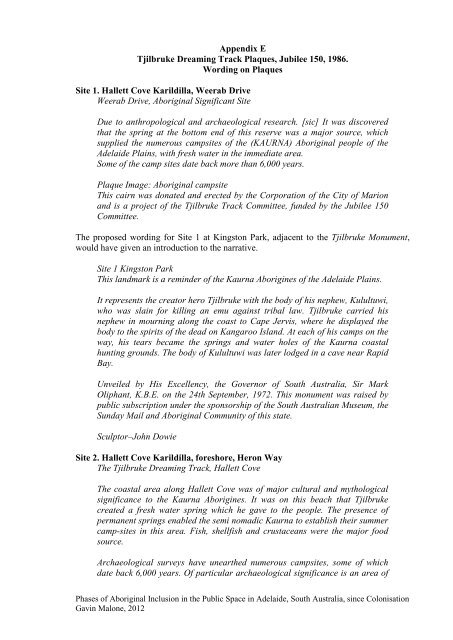Appendix A Ways of Belonging - Theses - Flinders University
Appendix A Ways of Belonging - Theses - Flinders University
Appendix A Ways of Belonging - Theses - Flinders University
You also want an ePaper? Increase the reach of your titles
YUMPU automatically turns print PDFs into web optimized ePapers that Google loves.
<strong>Appendix</strong> ETjilbruke Dreaming Track Plaques, Jubilee 150, 1986.Wording on PlaquesSite 1. Hallett Cove Karildilla, Weerab DriveWeerab Drive, Aboriginal Significant SiteDue to anthropological and archaeological research. [sic] It was discoveredthat the spring at the bottom end <strong>of</strong> this reserve was a major source, whichsupplied the numerous campsites <strong>of</strong> the (KAURNA) Aboriginal people <strong>of</strong> theAdelaide Plains, with fresh water in the immediate area.Some <strong>of</strong> the camp sites date back more than 6,000 years.Plaque Image: Aboriginal campsiteThis cairn was donated and erected by the Corporation <strong>of</strong> the City <strong>of</strong> Marionand is a project <strong>of</strong> the Tjilbruke Track Committee, funded by the Jubilee 150Committee.The proposed wording for Site 1 at Kingston Park, adjacent to the Tjilbruke Monument,would have given an introduction to the narrative.Site 1 Kingston ParkThis landmark is a reminder <strong>of</strong> the Kaurna Aborigines <strong>of</strong> the Adelaide Plains.It represents the creator hero Tjilbruke with the body <strong>of</strong> his nephew, Kulultuwi,who was slain for killing an emu against tribal law. Tjilbruke carried hisnephew in mourning along the coast to Cape Jervis, where he displayed thebody to the spirits <strong>of</strong> the dead on Kangaroo Island. At each <strong>of</strong> his camps on theway, his tears became the springs and water holes <strong>of</strong> the Kaurna coastalhunting grounds. The body <strong>of</strong> Kulultuwi was later lodged in a cave near RapidBay.Unveiled by His Excellency, the Governor <strong>of</strong> South Australia, Sir MarkOliphant, K.B.E. on the 24th September, 1972. This monument was raised bypublic subscription under the sponsorship <strong>of</strong> the South Australian Museum, theSunday Mail and Aboriginal Community <strong>of</strong> this state.Sculptor–John DowieSite 2. Hallett Cove Karildilla, foreshore, Heron WayThe Tjilbruke Dreaming Track, Hallett CoveThe coastal area along Hallett Cove was <strong>of</strong> major cultural and mythologicalsignificance to the Kaurna Aborigines. It was on this beach that Tjilbrukecreated a fresh water spring which he gave to the people. The presence <strong>of</strong>permanent springs enabled the semi nomadic Kaurna to establish their summercamp-sites in this area. Fish, shellfish and crustaceans were the major foodsource.Archaeological surveys have unearthed numerous campsites, some <strong>of</strong> whichdate back 6,000 years. Of particular archaeological significance is an area <strong>of</strong>Phases <strong>of</strong> Aboriginal Inclusion in the Public Space in Adelaide, South Australia, since ColonisationGavin Malone, 2012















